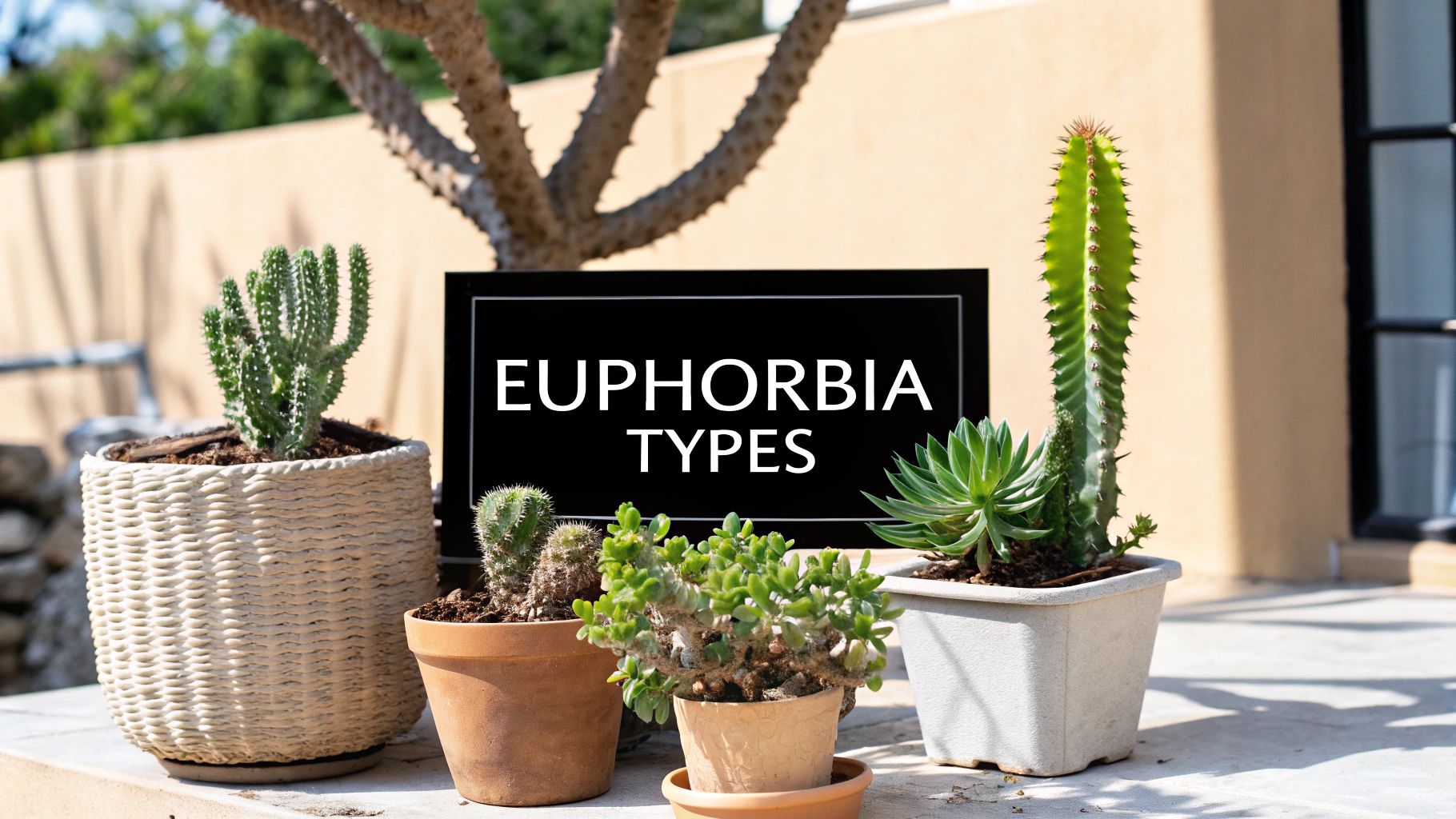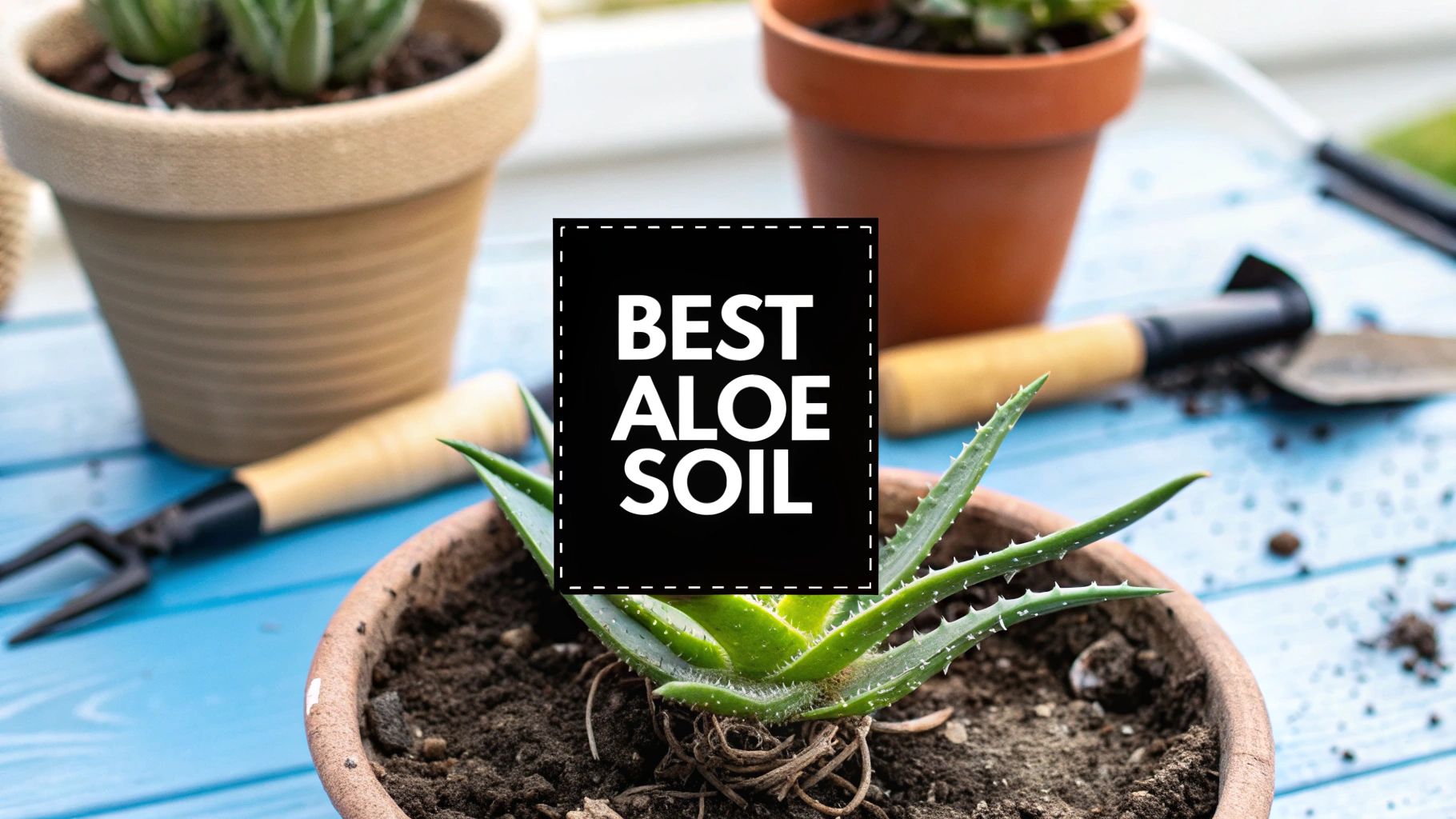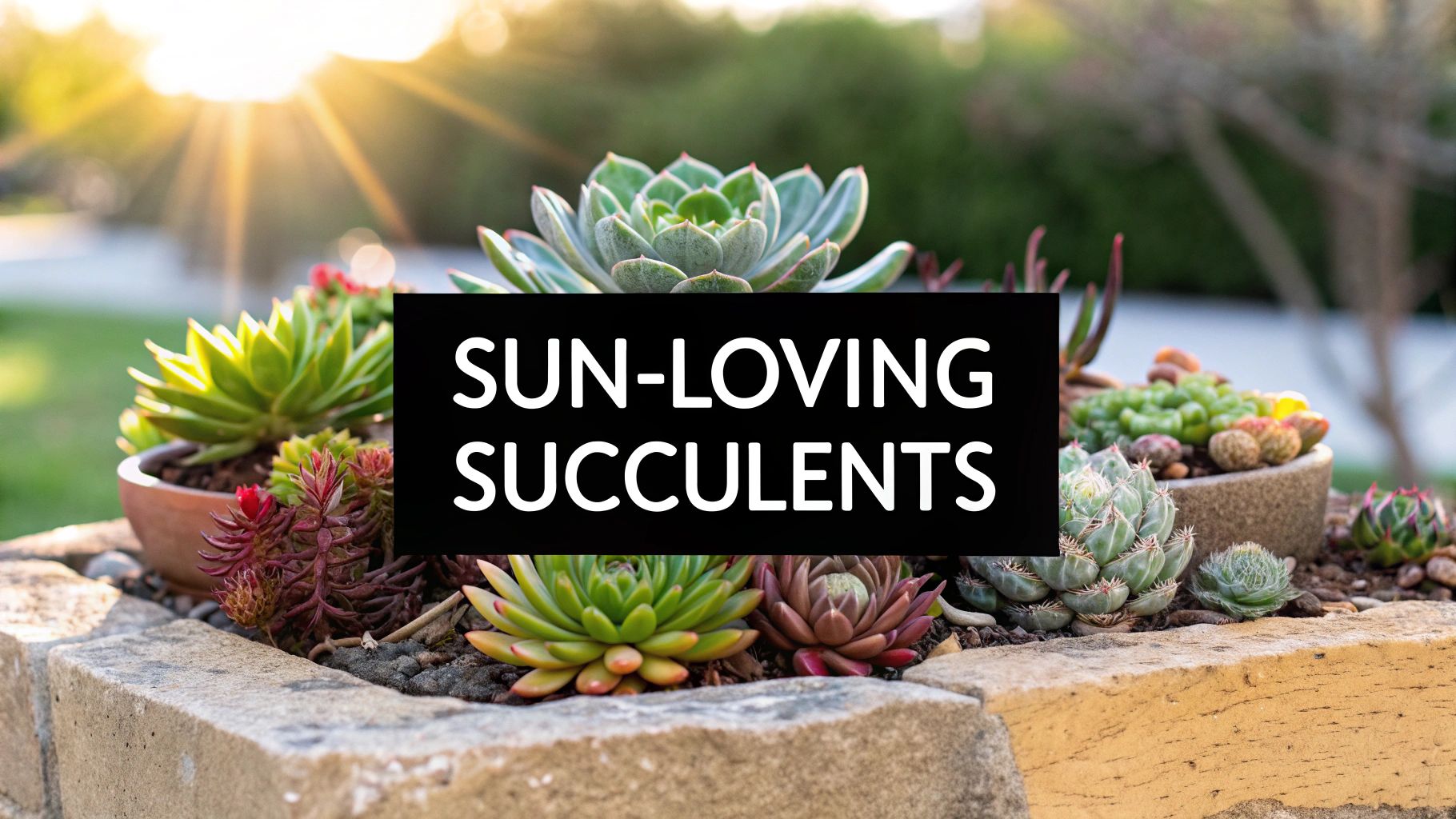It's a classic case of mistaken identity in the plant world. You see a spiny, sculptural plant that looks for all the world like a cactus, but it’s actually a clever imposter from the massive Euphorbia genus. These succulents are masters of mimicry, a fantastic example of convergent evolution.
Essentially, they developed the same survival toolkit as true cacti—fleshy, water-storing bodies and sharp spines—to thrive in similar harsh, dry climates. The key difference is that they evolved these traits completely independently.
The Great Cactus Imposters
So, how do you tell the difference between a Euphorbia and a true cactus? It can be tricky at first glance, but a few dead giveaways separate these lookalikes. The evolutionary mimicry is so spot-on that without knowing what to look for, you could easily be fooled.
The most reliable sign is hidden inside.
If you accidentally damage a true cactus, the sap that oozes out is usually clear and watery. But if you nick a Euphorbia, it will bleed a milky white latex. Be careful, though—this sap is often toxic and can seriously irritate your skin, so always handle these plants with gloves.
Another tell-tale sign is where the spines come from. It’s all about the anatomy.
- True Cacti: Their spines always emerge from small, cushion-like bumps called areoles. You'll often see multiple spines, and sometimes even flowers or new branches, sprouting from a single areole.
- Euphorbias: Their spines are different. They are essentially modified branches or stipules that grow directly from the plant's stem, without any areoles in sight.
Understanding the Euphorbia Genus
The sheer scale of this plant family is just staggering. The genus Euphorbia is one of the largest in the plant kingdom, boasting over 2,000 species found all over the globe. Of those, about 45% are succulents or xerophytes (plants adapted to dry conditions), which explains why so many have that classic cactus look. If you're curious, you can learn more about the incredible diversity of the Euphorbia genus.
To make it easier, here's a quick cheat sheet to help you spot the differences in the wild (or at the nursery).
Euphorbia vs True Cactus Quick Identification Guide
| Feature | Euphorbia | True Cactus (Cactaceae) |
|---|---|---|
| Sap | Milky white latex (often toxic) | Clear, watery sap |
| Spines | Emerge directly from the stem | Grow from cushion-like areoles |
| Flowers | Often small, colorful, and complex (called cyathia) | Typically large, showy, and radially symmetrical |
| Geographic Origin | Primarily Old World (Africa, Asia, Europe) | Exclusively New World (The Americas) |
This simple guide cuts through the confusion, helping you quickly identify whether you're looking at a clever "imposter" or the real deal.

The image above does a great job of showing how nature arrived at a similar design for desert survival through two completely different plant families. Each has its own unique biological blueprint.
Once you know these foundational differences, you'll be able to spot and appreciate the unique qualities of both Euphorbias and their true cactus cousins. It’s like being in on a little secret of the plant world.
Getting to Know the Columnar Euphorbia Varieties
The Euphorbia genus is enormous, boasting over 2,000 species, but the ones that really steal the show are often the columnar types. These are the imposters that grow straight up, creating strong, vertical silhouettes that look fantastic as architectural centerpieces, both in the garden and inside the home. They can reach some pretty impressive heights, closely mimicking the classic look of a Saguaro or an Organ Pipe cactus.
There's something about their commanding presence that brings a real sense of structure and scale to a plant collection. They make incredible statement pieces, whether you use them to add a bit of height to a succulent arrangement or just let one stand on its own like a living sculpture.
The African Milk Tree: An Iconic Favorite
If you’ve seen a columnar euphorbia before, there’s a good chance it was the African Milk Tree (Euphorbia trigona). This plant is a crowd-pleaser for a reason. Its distinctive, three-sided stems are lined with tiny leaves and thorns, and it grows surprisingly fast. You’ll often find the standard green version, but keep an eye out for the 'Rubra' or 'Royal Red' cultivars, which have stunning deep red and burgundy colors.
Even though it can eventually grow up to nine feet tall, it’s a remarkably easy plant to manage indoors. Its speedy growth makes it incredibly satisfying for beginners who want a dramatic look without waiting for years.
The African Milk Tree really is the perfect example of a plant that delivers a huge visual punch for very little effort. It’s happy with a simple routine of bright, indirect light and a "less is more" watering schedule, making it a fantastic starting point for anyone new to large succulents.
Candelabra Tree: A True Giant Reaching for the Sky
Now, if you have the room for something truly massive, the Candelabra Tree (Euphorbia ingens) is a showstopper. This one comes from southern Africa, where it can become a colossal, tree-like succulent towering over 40 feet high. It develops a thick main trunk and sends out tons of branching arms that sweep upwards, looking just like a massive candelabra.
Don't worry, it's much more manageable when grown in a pot, usually staying under 10 feet tall. To keep its strong, robust shape, it needs a ton of direct sun. Because of how big it can get and its branching nature, it’s really best for a spacious outdoor garden in a warm climate or a very large room with plenty of sunlight.
Care Tips for Your Columnar Giants
Looking after these upright growers is pretty simple, but their size does mean you need to keep a few things in mind. The world of succulents is incredibly diverse, so knowing the specifics of your plant's family is a huge help. For a wider perspective, you can discover more about the different types of cacti and their relatives to get a better handle on what they need.
- Light: Give them at least 6 hours of bright, direct sun every day. A south-facing window is usually the perfect spot indoors.
- Water: Stick to the "soak and dry" method. When you water, do it thoroughly until it runs out the bottom, but then let the soil dry out completely before you even think about watering again. In the winter, cut back to once a month or even less.
- Soil: Root rot is the number one enemy. A gritty, fast-draining cactus and succulent soil mix is non-negotiable.
- Support: As they shoot up, some of the taller columnar Euphorbias can get a bit top-heavy. You might need to give them a hand with a stake or some other kind of support to keep them upright and stable.
Exploring Unique Architectural Euphorbias

While the tall, columnar types bring the drama, the Euphorbia genus has a wild side full of bizarre and wonderful shapes that look like they were sculpted by an artist. These aren't your average upright plants; we're talking about spheres, snaking arms, and other almost alien-like structures. They are true living sculptures, perfect for collectors who really appreciate the stranger side of the plant world.
These unique euphorbias often become prized possessions for good reason. Their fascinating forms are the result of incredible adaptations to their native environments, making them so much fun to grow and watch.
The Perfectly Round Baseball Plant
One of the most recognizable architectural species has to be the Baseball Plant (Euphorbia obesa). It's not hard to see how it got its name. This plant grows into an almost perfect sphere, looking just like a plump, green baseball. Its body is marked with vertical ribs that really add to its geometric charm, and it stays wonderfully compact, rarely getting bigger than a softball.
This plant is a classic case of convergent evolution, where it evolved to look a lot like a small barrel cactus even though it isn't one. Native to South Africa, it can eventually reach about 20 cm (around 7.87 inches) tall and 9 cm (3.5 inches) wide. It typically has 8–10 distinct vertical ribs that create that signature spherical shape.
Because it grows so slowly and stays a manageable size, the Baseball Plant is a perfect fit for container gardening. It's a low-maintenance little oddity that adds a touch of minimalist, quirky charm to any sunny windowsill or succulent collection.
Medusa's Head: A Sprawling Spectacle
If you want something with a completely different kind of architectural vibe, look no further than Medusa's Head (Euphorbia flanaganii). This incredible plant grows from a central, thickened head (called a caudex) that sprouts dozens of slender, snake-like arms radiating outwards. These sprawling stems can create a stunning, trailing effect, which is why it looks amazing in a wide, shallow bowl or even a hanging basket.
The serpentine arms give the plant a dynamic sense of movement, as if it was frozen mid-slither. It’s a wild and untamed look, a total contrast to the static perfection of the Baseball Plant. Its unique structure is an instant conversation starter and is guaranteed to catch the eye of anyone who sees it. You can learn more about how https://www.cactusoutlet.com/blogs/blog/cacti-vs-euphorbia-similar-but-different. When you bring these kinds of statement plants into your home, it's worth thinking about their visual impact; some good effective space planning can help you place them perfectly to elevate your decor.
Specialized Care for Collector's Items
These special plants aren't necessarily difficult, but they do have specific needs.
- Potting: Always use a gritty, fast-draining soil mix. These species are highly susceptible to root rot if they sit in wet soil.
- Watering: Less is more. Let the soil dry out completely between waterings, and cut back even further during the winter months.
- Light: Give them bright, indirect sunlight. They love light, but harsh, direct sun can easily scorch their unique surfaces.
Meet the Flowering and Leafy Euphorbias

When most people think of Euphorbias, they immediately picture spiny, architectural plants that could easily be mistaken for a cactus. And while that's true for many of them, there's a whole other side to this family—one filled with vibrant flowers and eye-catching foliage.
These leafy and flowering varieties show just how incredibly diverse the genus is. They prove that you don't have to choose between a plant that's tough and one that's beautiful. They offer a softer look, bringing year-round color and unique texture to any collection.
Crown of Thorns: The Prolific Bloomer
Ask any succulent lover about a reliable flowering plant, and the Crown of Thorns (Euphorbia milii) will likely be at the top of their list. This little powerhouse from Madagascar is known for its thorny, woody stems and the clusters of bright flowers it seems to produce almost nonstop.
What's fascinating is that the "petals" we see aren't petals at all. They're actually colorful modified leaves called bracts, which come in shades of red, pink, yellow, and white. This plant practically thrives on a bit of neglect, making it a fantastic choice for anyone who wants the resilience of a succulent but the cheerful vibe of a classic flowering plant.
If you're more accustomed to the classic, robust cactus shapes, it’s interesting to see how different this Euphorbia is. For a great comparison, you can explore the more traditional forms found in different types of barrel cacti.
The Crown of Thorns is incredibly forgiving. It can handle less-than-perfect conditions and still put on a spectacular floral show, making it a perfect starting point for beginners who want reliable color without all the fuss.
Pencil Cactus: A Cascade of Fiery Color
Another standout that puts foliage first is the Pencil Cactus (Euphorbia tirucalli), especially its famous 'Firesticks' cultivar. This plant is all about its structure—a dense, tangled mass of slender stems that look just like their name suggests.
For most of the year, the stems are a cool green. But give it plenty of direct sunlight, and the magic happens. The tips ignite into brilliant shades of red, orange, and yellow, looking almost like a piece of coral from the sea.
While it can grow into a massive, tree-like shrub outdoors—sometimes reaching up to 30 feet—it’s much more manageable when kept in a pot. It provides a stunning, whimsical texture that contrasts beautifully against plants with broader leaves.
Care for Maximum Color and Blooms
Getting the best out of these leafy and flowering Euphorbias just means tweaking your care routine to highlight what makes them special.
- Bring on the Sun: For a Crown of Thorns, at least 4-6 hours of direct sunlight a day will keep the blooms coming. For 'Firesticks', the more sun it gets, the more intense its fiery colors become.
- Feed During the Growing Season: A little boost goes a long way. Give them a balanced, half-strength liquid fertilizer every 2-4 weeks in the spring and summer to fuel new flowers and vibrant growth.
- Prune for a Fuller Plant: Don't be afraid to give them a light trim. Pruning encourages bushier growth and creates more spots for flowers to emerge. Just remember to always wear gloves—that milky white sap can be irritating
Getting the Hang of General Euphorbia Care
While the Euphorbia genus is incredibly diverse, the good news is that their basic care needs are surprisingly similar. Think of it this way: a sports car and a pickup truck look totally different, but they both need gas and regular oil changes. It's the same idea here. Most succulent Euphorbias thrive on the same handful of principles.
Nailing these fundamentals is the secret to a healthy, happy collection. And it all starts from the ground up—literally—with the right soil.
The Foundation: Well-Draining Soil
The golden rule for growing just about any succulent Euphorbia is to avoid "wet feet." These plants come from dry places where water vanishes almost as soon as it hits the ground. If their roots are stuck in soggy, waterlogged soil, they're prime candidates for root rot, which is usually a death sentence.
Your best defense is a gritty, fast-draining soil mix. You can grab a bag of pre-made cactus and succulent soil, or you can easily mix your own. A great recipe is equal parts potting soil, perlite (or pumice), and coarse sand. This blend lets water flow right through, preventing rot while holding just enough moisture and nutrients for the plant to grab what it needs.
Perfecting Your Watering Routine
Without a doubt, the most common mistake people make is overwatering. The best way to get it right is to use the “soak and dry” method. When the soil is bone dry, give the plant a thorough drenching until you see water running out of the drainage holes. Then comes the most important part: let the soil dry out completely before you even think about watering again.
- Growing Season (Spring/Summer): During their active growth spurts, you might find yourself watering every 2-3 weeks. This really depends on your local climate, humidity, and the size of the pot.
- Dormant Season (Fall/Winter): As the weather cools down, the plant’s metabolism slows, and its water needs plummet. Cut back your watering schedule to once a month, or maybe even less.
Providing the Right Light
Euphorbias are sun-worshippers, but just how much sun they need can vary a bit. As a general rule, most will want at least 4-6 hours of bright, direct sunlight every day. This is what keeps them from getting leggy and helps maintain those vibrant colors we love. A south-facing window is usually the perfect spot indoors.
That said, be careful with the intense, scorching afternoon sun, especially in hotter climates. If you start seeing yellow or brown scorch marks on your plant, it’s a cry for help—it's getting sunburned. Just move it to a spot with bright, indirect light or where it only gets the gentler morning sun.
Safety First: We can't talk about Euphorbia care without a serious safety note. Nearly all of them produce a milky white sap that is toxic. It can cause nasty skin irritation and is especially dangerous if it gets in your eyes. Always, always wear gloves and eye protection when you're pruning or handling a broken plant.
This genus is also incredibly adaptable, growing successfully across hardiness zones 5 through 11. This shows just how well they can handle climates from temperate to tropical, which is a big reason for their global popularity. You’ll often see Euphorbias used in drought-tolerant landscaping thanks to their slow-to-moderate growth and minimal water needs. For a deeper dive into where they pop up around the world, you can explore Euphorbia’s global distribution on gbif.org.
Even with the best care, problems can sometimes arise. This troubleshooting table can help you quickly diagnose and fix common issues you might encounter with your Euphorbia.
Euphorbia Care Troubleshooting Guide
| Symptom | Potential Cause | Solution |
|---|---|---|
| Yellow, mushy base or stems | Root rot from overwatering | Let soil dry completely. If severe, unpot, trim away rotted roots, and repot in fresh, dry, gritty soil. |
| Shriveled, wrinkled leaves/stems | Underwatering | The plant is thirsty! Give it a thorough watering using the "soak and dry" method. It should plump up in a day or two. |
| Brown or yellow scorch spots | Sunburn | Too much intense, direct sun. Move the plant to a location with bright, indirect light or only morning sun. |
| Stretching or "leggy" growth | Insufficient light | The plant is reaching for more sun. Gradually move it to a brighter location to encourage more compact growth. |
| White, cottony pests | Mealybugs | Isolate the plant. Dab the pests with a cotton swab dipped in 70% isopropyl alcohol. For larger infestations, use insecticidal soap. |
Remember, observation is key. Checking in on your plants regularly will help you catch these signs early, making it much easier to get them back on track.
Common Questions About Euphorbia Plants

Even after you've got a good care routine down, you're bound to run into questions. Euphorbias have their own unique quirks, and sometimes they do things that leave you scratching your head.
Think of this section as your go-to guide for those "what's happening with my plant?" moments. We'll cover some of the most common issues we hear about, from safety concerns to troubleshooting tips, so you can grow your collection with confidence.
Is Euphorbia Sap Dangerous to Touch?
Yes, you need to be very careful with it. That milky white latex that oozes out of a cut or broken Euphorbia is toxic and a major irritant. It’s the plant’s defense mechanism, and it's surprisingly potent.
If it gets on your skin, it can cause anything from a mild rash to some pretty painful inflammation. The real danger is getting the sap in your eyes—it can cause intense pain and even temporary blindness.
Always wear gloves and protective eyewear when you’re pruning, repotting, or handling a damaged Euphorbia. If you get sap on your skin, wash it off right away with soap and water. If it gets in your eyes, flush them with water for at least 15 minutes and get medical help.
How Can I Make My Crown of Thorns Bloom More?
Getting a Crown of Thorns (Euphorbia milii) to really put on a show comes down to three things: light, water, and food. Get this trio right, and you’ll be rewarded with a nearly constant display of those colorful bracts.
- Maximize Sunlight: These plants are sun-lovers. They need at least 4-6 hours of direct, bright sunlight every single day to get the energy they need for flowering. A south-facing window is usually the perfect spot indoors.
- Water Correctly: Drench the soil thoroughly, but only when the top inch or two of soil is completely dry to the touch. If you water too often, you'll get root rot, not more flowers.
- Feed It: During the spring and summer growing season, give your plant a boost every 2-4 weeks. A balanced, water-soluble fertilizer diluted to half-strength is perfect.
One little trick is to cut back on water just a bit during the winter. This little bit of "stress" often encourages an even bigger burst of blooms once spring arrives.
Why Are the Stems of My African Milk Tree Turning Soft?
Soft, mushy stems on an African Milk Tree (Euphorbia trigona) almost always scream one thing: root rot from overwatering. When the soil stays soggy for too long, the roots can't breathe. They start to decay, and that rot quickly travels up into the base of the plant.
You have to act fast to have a chance of saving it. Take the plant out of its pot and take a look at the roots. Using a clean, sharp knife, cut away any parts of the root or stem that look black, mushy, or feel soft.
Let the healthy cuttings or the remaining plant sit out in a dry, shady spot for several days, maybe even a week. This gives the fresh cuts time to callus over, which is crucial for preventing more rot. Once they're callused, you can repot them in fresh, dry, fast-draining cactus mix. From here on out, be patient and only water when the soil is 100% dry.
As you get comfortable with caring for different Euphorbias, you might also look for new ideas for incorporating plants into your home décor to really make your space come alive.




